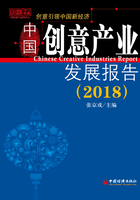
Foreword
Foreword
As an important year of China's implementing its 13th five-year plan, the year of 2017 has witnessed a further reform of supply-side. The 19th Congress of the Communist Party of China(CPC)has successfully established the historical status of the Xi Jinping's Thought on Socialism with Chinese Characteristics for a New era, while blowing the bugle of finishing the process of a moderately prosperous society in all respects and striving for the great victory of the socialism with Chinese characteristics in the new era by developing the frameworks and guidelines conforming to the requirements of the times and wish of Chinese people. As it noted, the principal contradiction facing Chinese society in the new era is that between unbalanced and inadequate development and the people's ever-growing needs for a better life. This is a significant and epoch-making judgement for the various undertakings of the part and country.
Speaking of the cultural territory, Xi Jinping, the General Secretary of CPC, noted that without full confidence in our culture, without a rich and prosperous culture, the Chinese nation will not be able to rejuvenate itself. We must develop a socialist culture with Chinese characteristics, inspire the cultural creativity of our whole nation, and develop a great socialist culture in China. The socialist culture with Chinese characteristics is derived from China's fine traditional culture, which was born of the Chinese civilization and nurtured over more than 5, 000 years; it has grown out of the revolutionary and advanced socialist culture that developed over the course of the Chinese people's revolution, construction, and reform under the Party's leadership; and it is rooted in the great practice of socialism with Chinese characteristics. To develop socialist culture, we should follow the principle of letting a hundred flowers bloom and a hundred schools of thought contend, and encourage creative transformation and development, so as to add new luster to Chinese culture.
The traditional culture's creative transformation and idea development will generate innovative products and services, supporting the creative industry's growth. Cultural and Creative Industry can provide rich “soul food” that meets the people's demand for a better life. It flourishes literary and artistic creation in a market-oriented way, promotes the reform of cultural system, keeps innovating the ways of producing the cultural products and services, breeds new format of cultural industry and enhances China's soft power of culture. We can see the traditional culture's promotion and creative industry's development by a fact that China has 12 cities chosen into the UNESCO's “Creative Cities Network” in 2017, ranking high by the number. These cities are Beijing, Shanghai, Shenzhen, Suzhou, Hangzhou, Wuhan, Changsha, Chengdu, Qingdao, Macau, Jingdezhen and Shunde. Best known for City of Design, Gastronomy, Crafts & Folk Art, Media Arts, Film, except City of Literature and Music, they are bridgeheads for showcasing of the Chinese culture and achievements of creative industry, proving that the appeal and confidence of Chinese culture are increasingly gaining world-wide recognition and respect.
Based on the above-mentioned facts, The Chinese Creative Industries Report 2018 focuses on the latest achievement on industrializing the traditional culture and building the creative cities. This report first used the coverage of these 12 cities and gave consideration to the stories of creative industry development from other potential cities, such as Sipsong Panna, Xining and Guiyang, especially focusing on industrialization of traditional culture. Reports from these cities tried to describe and analyze the development of local creative industry in 2017, and a few of them mainly on qualitative analysis of their historical development due to their limited statistics and times of be selected in to the blue paper. But most reports have provided the development mode of traditional culture in the local creative industry, involving hot news of the year, case description and in-depth analysis. Some cities have also introduced their experience of building creative city. We will read reviews on development and future trend from these cities.
The Chinese Creative Industries Report 2018 used a typical “deduction and summary” structure, emphasizing on a combination of individual cases and general scenario and that of description and analysis. Its opening part focuses on the trend and characteristics of Chinese creative industry in 2017 from a strategic view point, following and analyzing some emerging business like webcasting and short video, especially discussing some big events and trends that have played a role in creative industry development such as The Film Industry Stimulation Law of P. R. C and the integration of culture and tourism. The main part of report covers the latest development of creative industry in 16 cities, including Beijing, Hangzhou, Qingdao, Wuhan, Shenzhen, Chengdu and Xi'an. By analysis, its last part makes a judgement that the development of traditional culture has offered a push for creative industries and creative cities.
Chinese Creative Industries Report 2018 is the 13rd blue book of tracking Chinese creative industry. Sea changes happened frequently during these 13 years. Sticking to the idea of academic freedom and our goal on the study, we endured many hardships but forged ahead. We want to genuinely thank our readers and cooperators for their long-term support. However the industry will go and whatever difficulty will stay ahead of our team, we hope we will keep our study in this field and work with them. We also hope the relevant department of the government, universities, research institutions and experts will join us to help write the Blue Book of Creative Cities, which will be published as a part book about city of this report, so that we can work along for boosting this industries.